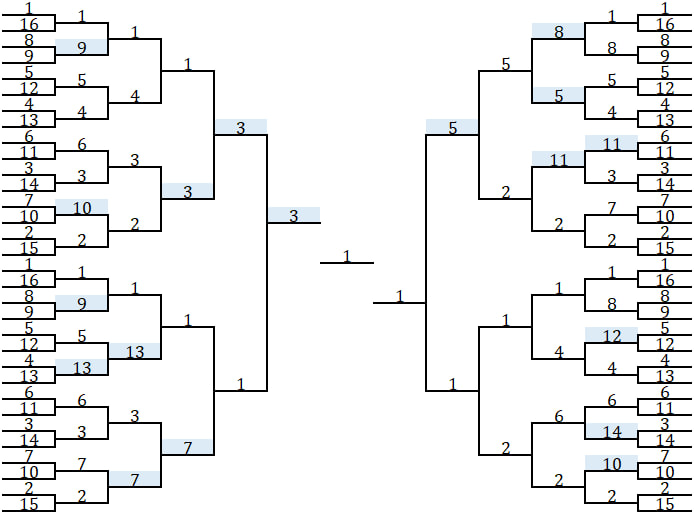RatingsArticle Archive |
A Typical March Madness BracketWhen filling out a March Madness bracket, there are couple well-known axioms that virtually every fan knows: Always pick a #12 seed to win in the first round, and never pick all four #1 seeds to reach the Final Four.
But outside of that advice, there’s a tendency for people to pick excessively chalky brackets. I’m going to walk through an average year, based on averages since 1985 when the field expanded to 64 teams, and establish three new axioms that I’d encourage everyone to adopt. So let’s take a look at our theoretically average tournament: First round The first round is the books! There were eight total upsets. Two of them were simply #9 seeds beating #8 seeds—hardly worthy of being called an upset. Seeds #10 through #12 got four of the upsets. And there were two upsets by teams #13 and worse. Axiom #1: Always expect at least one team seeded #13 or worse to win a game. Only five times out of 39 years have all #13 through #16 seeds failed to win a game. And most tournaments have seen two or more of these upsets. Second round On to the second round! There were five total upsets. A #2 seed lost. And there are two double-digit teams advancing to the Sweet Sixteen. Axiom #2: Always expect at least one double-digit seed to make the Sweet Sixteen. Only twice have all double-digit teams failed to reach the Sweet Sixteen. And most tournaments have seen two or more. Third round There were 2 upsets in the third round. There are only three #1 seeds left, and there are two teams seeded #5 or worse that advanced. Axiom #3: Always expect at least one seed #5 or worse to advance to the Elite Eight. Only three times has the Elite Eight consisted entirely of teams seeded #4 and better. Fourth round and beyond. Historically, the fourth round is the most upset-heavy round of all, featuring a whopping 44% of games ending in the worse seed winning. On average, the Final Four consists of two #1 seeds, a #2 or #3 seed, with the fourth team being #4 or worse. In the semi-finals and finals, things tend to get chalky, with a #1 seed taking home the trophy more than half the time. Summary When it’s all said and done, the average tournament features about 18 upsets. So don’t be shy when filling out your brackets, and don’t be afraid to make a few bold predictions. Below is an example of what an “average” tournament might look like. Upsets are highlighted. |
|



